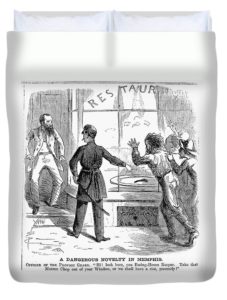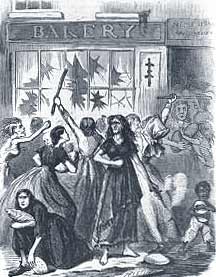The majority of Southerners, soldiers and civilians, experienced severe shortages of food early in the Civil War. Keeping the army fed was a large obstacle for the leaders, but keeping the people fed at home was even more difficult. This was because most of the farming men were in the armed forces and many of the farm lands became battlefields. Where there might be a good crop of vegetables in one location, there was seldom any method of getting that food to people who were hungry elsewhere.
North Georgia seemed to have enough food until the fighting was nearby in 1862-63. The situation grew bleak more than 40,000 men encamped in the valleys around Dalton waiting for spring fighting to begin again. Much of the hunger was because any available food went to the fighting men. Many of the population were hungry to the very point of starvation. Some people fled the region due to the fighting and lack of food only to find that there was no food to be found anywhere in Georgia.
As time progressed in the war, vegetable seed became almost impossible to find. And meat was very rare. It was said that during prayers for daily bread, there was usually added, “and a little meat too, O Lord.” The lack of salt was probably the most serious shortage because it was needed to preserve the small amounts of meat that were available. Many pounds of meat spoiled as the Union army captured or flooded the salt mines. The blockades at the ports prevented salt from being obtained and then transported.

“Civil War: Food Shortage” by Granger
By the fall of 1864, people had resorted to eating rats, frogs, crow, snakes, and even cats and dogs. The most expensive but somewhat available meat later in the war was mule meat. Beverages were also scarce with coffee being the most sorely missed, this shortage occurred early in the war as the blockade took effect. Leaves of blackberries, raspberries, huckleberries, and many others were used as tea substitutes. Alcoholic beverages were tremendously missed and the few that were available were very dangerous to drink. Moonshiners were very successful with products made from corn and grain. They also used other things like sweet potatoes, or rice. These beverages were described as “unpalatable” and “vile,” but were able to get the job done! Desperate times call for desperate measures.

In some areas across the South, the lack of food led to what is now called the “Southern bread riots”. The Southern bread riots were led mostly by women in March and April 1863. The most infamous one occurred on April 2, 1863, in the Confederate capital of Richmond, Virginia. It was organized and instigated by Mary Jackson, a peddler and mother of a soldier, and Martha Fergussen. The women began a riot when Governor Letcher refused to discuss the food shortage with them. They looted shops, stole carts and broke into storage lockers. Chanting “bread or blood!”, the women seized a wagon of beef bound for a hospital, and 500 pounds of bacon from a warehouse. Food wasn’t the only item stolen–jewelry shops and milliners were victimized as well. Soon Governor Letcher was on the scene, as well as Jefferson Davis himself, who tried to appease the women by offering them his last loaf of bread. The Militia arrived quickly to restore order, but not before tens of thousands of dollars’ worth of items were stolen. Jackson, Fergussen and a few other women were rounded up and placed in jail, but released within weeks. The reason? Overcrowded jails couldn’t afford to feed all the prisoners. The bread riots of 1863 highlighted how desperate the situation had become on the home front. They also showed the slow but steady demoralization that profoundly affected the Confederate cause.

Richmond Bread Riots
On a more upbeat note, some decided that “starvation parties” were necessary. These were simple gatherings that had fellowship with friends and water. Often there would be a fiddler who played music for dancing. There were no refreshments, but guests might bring a family recipe to read and share with the group. Mary Chestnut wrote in her diary that while this failed to fill your appetite, it was “good for the digestion”. One recipe that might have been shared was “Confederate Johnnie Cake”. Check it out at the end of the article and try to make it home!
Even after the Civil War ended hunger and lack of resources plagued the South for many years. Many people became resourceful with what they had, and this also led to the lowly peanut becoming one of Georgia’s top plants. One of the new things, we hope to do when the Museum opens back for tours and field trips is to teach how to make butter at home. We hope you can come visit us soon and learn more about the Civil War and how it influenced life in North Georgia!
“Confederate Johnnie Cake”
Heat Oven to 425 degrees
Melt half a stick of margarine in 9×9 pan
1 ¼ cup flour
4 tsp baking powder
1 tsp salt
¼ cup sugar
¾ cup cornmeal
1 cup milk
1 egg
Mix above ingredients in pan with melted margarine. And then bake 20 minutes.




